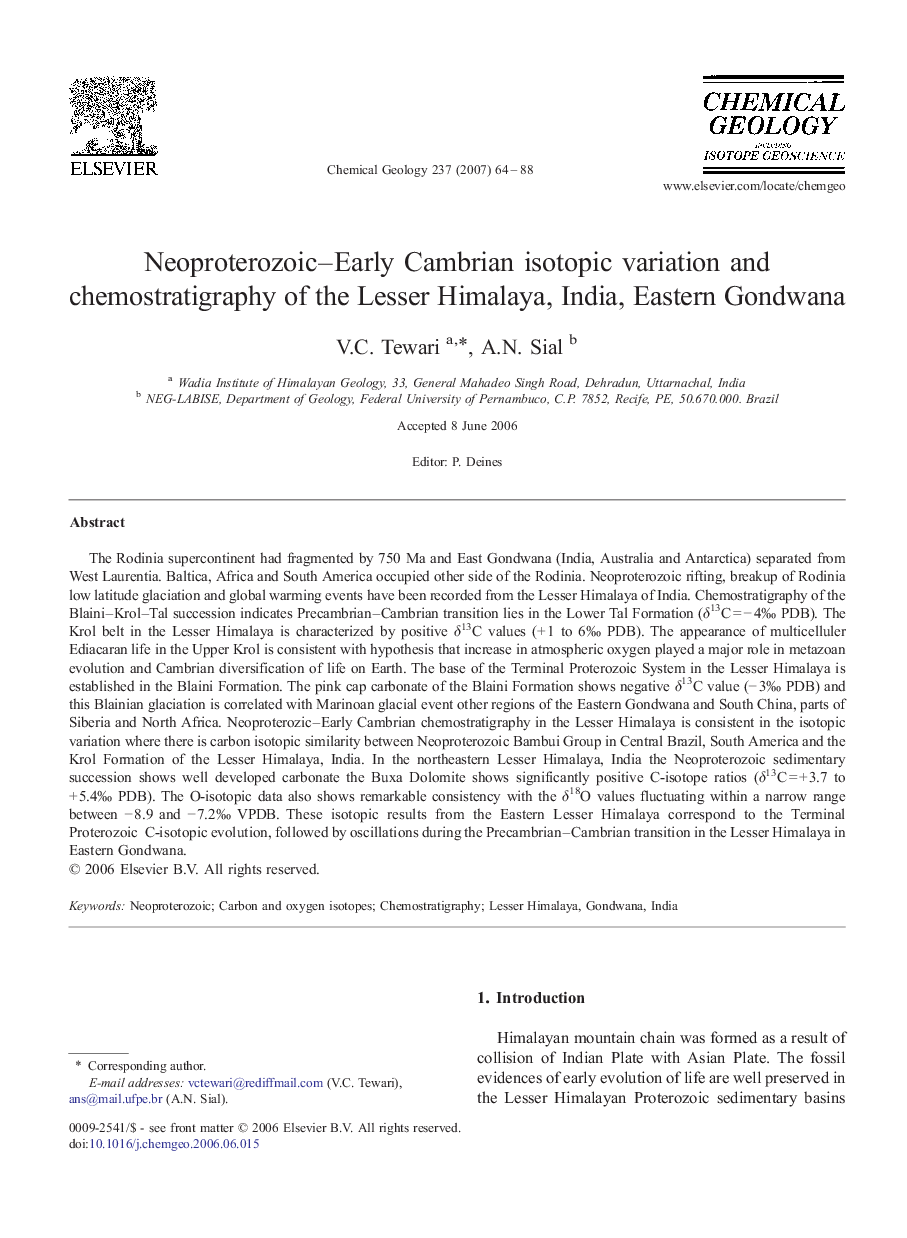| کد مقاله | کد نشریه | سال انتشار | مقاله انگلیسی | نسخه تمام متن |
|---|---|---|---|---|
| 4701104 | 1637756 | 2007 | 25 صفحه PDF | دانلود رایگان |
عنوان انگلیسی مقاله ISI
Neoproterozoic-Early Cambrian isotopic variation and chemostratigraphy of the Lesser Himalaya, India, Eastern Gondwana
دانلود مقاله + سفارش ترجمه
دانلود مقاله ISI انگلیسی
رایگان برای ایرانیان
کلمات کلیدی
موضوعات مرتبط
مهندسی و علوم پایه
علوم زمین و سیارات
ژئوشیمی و پترولوژی
پیش نمایش صفحه اول مقاله

چکیده انگلیسی
The Rodinia supercontinent had fragmented by 750 Ma and East Gondwana (India, Australia and Antarctica) separated from West Laurentia. Baltica, Africa and South America occupied other side of the Rodinia. Neoproterozoic rifting, breakup of Rodinia low latitude glaciation and global warming events have been recorded from the Lesser Himalaya of India. Chemostratigraphy of the Blaini-Krol-Tal succession indicates Precambrian-Cambrian transition lies in the Lower Tal Formation (δ13C = â 4â° PDB). The Krol belt in the Lesser Himalaya is characterized by positive δ13C values (+ 1 to 6â° PDB). The appearance of multicelluler Ediacaran life in the Upper Krol is consistent with hypothesis that increase in atmospheric oxygen played a major role in metazoan evolution and Cambrian diversification of life on Earth. The base of the Terminal Proterozoic System in the Lesser Himalaya is established in the Blaini Formation. The pink cap carbonate of the Blaini Formation shows negative δ13C value (â 3â° PDB) and this Blainian glaciation is correlated with Marinoan glacial event other regions of the Eastern Gondwana and South China, parts of Siberia and North Africa. Neoproterozic-Early Cambrian chemostratigraphy in the Lesser Himalaya is consistent in the isotopic variation where there is carbon isotopic similarity between Neoproterozoic Bambui Group in Central Brazil, South America and the Krol Formation of the Lesser Himalaya, India. In the northeastern Lesser Himalaya, India the Neoproterozoic sedimentary succession shows well developed carbonate the Buxa Dolomite shows significantly positive C-isotope ratios (δ13C = + 3.7 to + 5.4â° PDB). The O-isotopic data also shows remarkable consistency with the δ18O values fluctuating within a narrow range between â 8.9 and â 7.2â° VPDB. These isotopic results from the Eastern Lesser Himalaya correspond to the Terminal Proterozoic C-isotopic evolution, followed by oscillations during the Precambrian-Cambrian transition in the Lesser Himalaya in Eastern Gondwana.
ناشر
Database: Elsevier - ScienceDirect (ساینس دایرکت)
Journal: Chemical Geology - Volume 237, Issues 1â2, 15 February 2007, Pages 64-88
Journal: Chemical Geology - Volume 237, Issues 1â2, 15 February 2007, Pages 64-88
نویسندگان
V.C. Tewari, A.N. Sial,